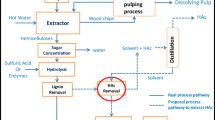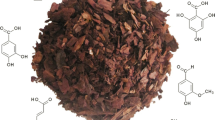Abstract
The sulphite pulping process for cellulose extraction consists of lignin depolymerisation of wood by sulphonation and hydrolysis leading to the production of spent sulphite liquor (SSL) as waste stream enriched in hemicellulose sugars and lignin derivatives. In this work, liquid–liquid extraction was used in order to separate phenolics from the sugar-rich SSL fraction. The effects of type of solvent, settling time, pH value, number of extraction stages and sample-to-solvent ratio were investigated. Folin–Ciocalteu and UNE-EN 16109 methods were used for the analysis of total phenolic content and total phenolic hydroxyl groups, respectively. The DPPH· method was used to determine the radical scavenging capacity of the extracts. Individual phenolic compounds were determined via HPLC–DAD analysis. Sugars and other compounds (5-hydroxymethylfurfural, furfural and acetic acid) were also quantified. Effective extraction of phenolic compounds was achieved using diethyl ether in a single extraction stage, at room temperature, at pH value of 3.6 and a sample-to-solvent ratio of 1:3 (v/v). The diethyl ether extract contained 6.31 g gallic acid equivalents per L, indicating strong antioxidant activity index (4.9), as well as 0.024 g/L 5-hydroxymethylfurfural, 0.025 g/L furfural, 2.89 g/L acetic acid and 1.4 g/L of sugars.







Similar content being viewed by others

References
Santos, R.B., Hart, P.W., Jameel, H., Chang, H.M.: Wood based lignin reactions important to the biorefinery and pulp and paper industries. BioResources 8, 1456–1477 (2013)
Llano, T., Rueda, C., Quijorna, N., Blanco, A., Coz, A.: Study of the delignification of hardwood chips in a pulping process for sugar production. J. Biotechnol. 162, 422–429 (2012)
Rueda, C., Lopez-Alvarez, J., Llano, T., Quijorna, N., Blanco, A., Viguri, J.R., Coz, A.: Physico-chemical characterization of a spent sulfite liquor oriented to its valorization options. In: 16th International Symposium on Wood, Fiber and Pulping Chemistry—Proceedings, ISWFPC, 1 Tianjin, China, pp. 584–587 (2011)
Palmqvist, E., Hahn-Hägerdal, B.: Fermentation of lignocellulosic hydrolysates. II: inhibitors and mechanisms of inhibition. Bioresour. Technol. 74, 25–33 (2000)
Willför, S.M., Ahotupa, M.O., Hemming, J.E., Reunanen, M.H.T., Eklund, P.C., Sjöholm, R.E., Eckerman, C.S.E., Pohjamo, S.P., Holmbom, B.R.: Antioxidant activity of knotwood extractives and phenolic compounds of selected tree species. J. Agric. Food Chem. 51, 7600–7606 (2003)
Jönsson, L.J., Alriksson, B., Nilvebrant, N.-O.: Bioconversion of lignocellulose: inhibitors and detoxification. Biotechnol. Biofuels 6, 1–10 (2013)
Garrote, G., Cruz, J.M., Moure, A., Domìnguez, H., Parajó, J.C.: Antioxidant activity of byproducts from the hydrolytic processing of selected lignocellulosic materials. Trends Food Sci. Technol. 15, 191–200 (2004)
Alexandri, M., Llano, T., Gardeli, C., Papapostolou, H., Komaitis, M., Papanikolaou, S., Coz, A., Koutinas, A.: Solvent extraction and analysis of phenolic compounds derived from spent sulphite liquor for enhanced succinic acid fermentation. In: 36th Symposium on Biotechnology for Fuels and Chemicals (2014)
Marinova, E.M., Yanishlieva, N.V.I., Kostova, I.V.: Antioxidative activity of extracts from selected species of the family Lamiaceae in sunflower oil. Food Chem. 58, 245–248 (1997)
Fernández de Simón, B., Cadahía, E., Conde, E., García-Vallejo, M.C.: Low molecular weight phenolic compounds in Spanish oak woods. J. Agric. Food Chem. 44, 1507–1511 (1996)
Cruz, J.M., Domínguez, J.M., Dominguez, H., Parajó, J.C.: Solvent extraction of hemicellulosic wood hydrolysates: a procedure useful for obtaining both detoxified fermentation media and polyphenols with antioxidant activity. Food Chem. 67, 147–153 (1999)
Faustino, H., Gil, N., Baptista, C., Duarte, A.P.: Antioxidant activity of lignin phenolic compounds extracted from kraft and sulphite black liquors. Molecules 15, 9308–9322 (2010)
Cruz, J.M., Domínguez, H., Parajó, J.C.: Antioxidant activity of isolates from acid hydrolysates of Eucalyptus globulus wood. Food Chem. 90, 503–511 (2005)
Waterhouse, A.L.: Determination of total phenolics. Curr. Protoc. Food Analyt. Chem. I1.1.1–I1.1.8 (2002)
Standard UNE-EN 16109: Fertilizers-determination of complexed micro-nutrients ions in fertilizers. Identification of lignosulfonates. http://www.en.aenor.es/aenor/normas/normas/fichanorma.asp?tipo=N&codigo=N0049498&PDF=Si#.VffJbBHtmkp. Accessed Sept 2015 (2012)
Scherer, R., Godoy, H.T.: Antioxidant activity index (AAI) by the 2,2-diphenyl-1-picrylhydrazyl method. Food Chem. 112, 654–658 (2009)
Brand-Williams, W., Cuvelier, M.E., Berset, C.: Free radical method to evaluate antioxidant acitivity: Lebensm. Wiss. U. Technol. 28, 25–30 (1995)
Guendez, R., Kallithraka, S., Makris, D.P., Kefalas, P.: Determination of low molecular weight polyphenolic constituents in grape (Vitis vinifera sp.) seed extracts: correlation with antiradical activity. Food Chem. 89, 1–9 (2005)
Proestos, C., Sereli, D., Komaitis, M.: Determination of phenolic compounds in aromatic plants by RP-HPLC and GC-MS. Food Chem. 95, 44–52 (2006)
Llano, T., Quijorna, N., Portilla, A.I., Andrés, A., Coz, A.: Analysis of sugars, intermediates and inhibitors in sulphite pulping by HPLC/RID. In: XXII TECNICELPA International Forest, Pulp and Paper Conference. Book of abstracts, 135 (2013)
Parajó, J.C., Domínguez, H., Domínguez, J.M.: Biotechnological production of xylitol. Part 3: operation in culture media made from lignocellulose hydrolysates. Bioresour. Technol. 66, 25–40 (1998)
Parajó, J.C., Domínguez, H., Dominguez, J.M.: Xylitol production from Eucalyptus wood hydrolysates extracted with organic solvents. Process. Biochem. 32, 599–604 (1997)
Khoddami, A., Wilkes, M.A., Roberts, T.H.: Techniques for analysis of plant phenolic compounds. Molecules 18, 2328–2375 (2013)
Neto, C.P., Belino, E., Evtuguin, D., Silvestre, A.J.D.: Total fractionation and analysis of organic components of industrial Eucalyptus globulus kraft black liquor. Appita J. 52, 213–225 (1999)
Marques, A.P., Evtuguin, D.V., Magina, S., Amado, F.M.L., Prates, A.: Chemical composition of spent liquors from acidic magnesium sulphite pulping of Eucalyptus globulus. J. Wood Chem. Technol. 29, 322–336 (2009)
Klinke, H.B., Thomsen, A.B., Ahring, B.K.: Inhibition of ethanol-producing yeast and bacteria by degradation products produced during pre-treament of biomass. Appl. Microbiol. Biotechnol. 66, 10–26 (2004)
Garrote, G., Cruz, J.M., Domínguez, H., Parajó, J.C.: Valorisation of waste fractions from autohydrolysis of selected lignocellulosic materials. J. Chem. Technol. Biotechnol. 78, 392–398 (2003)
Bonoli, M., Verardo, V., Marconi, E., Caboni, M.F.: Antioxidant phenols in barley (Hordeum vulgare L.) flour: comparative spectrophotometric study among extraction methods of free and bound phenolic compounds. J. Agric. Food Chem. 52, 5195–5200 (2004)
Molyneux, P.: The use of the stable free radical diphenylpicrylhydrazyl (DPPH) for estimating antioxidant activity. Songklanakarin J. Sci. Technol. 26, 211–219 (2004)
González, J., Cruz, J.M., Domínguez, H., Parajó, J.C.: Production of antioxidants from Eucalyptus globulus wood by solvent extraction of hemicellulose hydrolysates. Food Chem. 84, 243–251 (2004)
Kähkönen, M.P., Hopia, A.I., Vuorela, H.J., Rauha, J.P., Pihlaja, K., Kujala, T.S., Heinonen, M.: Antioxidant activity of plant extracts containing phenolic compounds. J. Agric. Food Chem. 47, 3954–3962 (1999)
Shevchenko, Y., Hemmerich, I., Helfert, J., Smetanska, I.: Influence of Stevia—additives on antioxidant properties of different green teas. Agro Food Ind. Hi. Tech. 24, 22–26 (2013)
Villaño, D., Fernández-Pachón, M.S., Moyá, M.L., Troncoso, A.M., García-Parrilla, M.C.: Radical scavenging ability of polyphenolic compounds towards DPPH free radical. Talanta 71, 230–235 (2007)
Rice-Evans, C., Miller, N., Paganga, G.: Antioxidant properties of phenolic compounds. Trends Plants Sci. 2, 152–159 (1997)
Fukumoto, L.R., Mazza, G.: Assessing antioxidant and prooxidant activities of phenolic compounds. J. Agric. Food Chem. 48, 3597–3604 (2000)
Lai, Y.Z., Guo, X.P.: Variation of the phenolic hydroxyl group content in wood lignins. Wood Sci. Technol. 25, 467–472 (1991)
Chandel, A.K., da Silva, S.S., Singh, O.V.: Detoxification of lignocellulose hydrolysates: biochemical and metabolic engineering toward white biotechnology. Bioenerg. Res. 6, 388–401 (2013)
Santos, S.A.O., Villaverder, J.J., Sousa, A.F., Coelho, J.F.J., Neto, C.P., Silvestre, A.J.D.: Phenolic composition and antioxidant activity of industrial cork by-products. Ind. Crops Prod. 47, 262–269 (2013)
Vermerris, W., Nicholson, R.: Phenolic Compound Biochemistry. Springer, Heidelberg (2008)
Bjørsvik, H.R., Liguori, L.: Organic processes to pharmaceutical chemicals based on fine chemicals from lignosulfonates. Org. Process Res. Dev. 6, 279–290 (2002)
Mateo, S., Roberto, I.C., Sánchez, S., Moya, A.J.: Detoxification of hemicellulose hydrolysate from olive tree pruning residue. Ind. Crops and Prod. 49, 196–203 (2013)
Acknowledgments
The authors gratefully acknowledge the financial support by KBBE-2012-6-311935 BRIGIT research project. www.brigit-project.eu. Ms. Tamara Llano acknowledges the Erasmus Mobility Program for her research stay in the Agricultural University of Athens during the Ph.D. study.
Author information
Authors and Affiliations
Corresponding authors
Rights and permissions
About this article
Cite this article
Llano, T., Alexandri, M., Koutinas, A. et al. Liquid–Liquid Extraction of Phenolic Compounds from Spent Sulphite Liquor. Waste Biomass Valor 6, 1149–1159 (2015). https://doi.org/10.1007/s12649-015-9425-9
Received:
Accepted:
Published:
Issue Date:
DOI: https://doi.org/10.1007/s12649-015-9425-9



